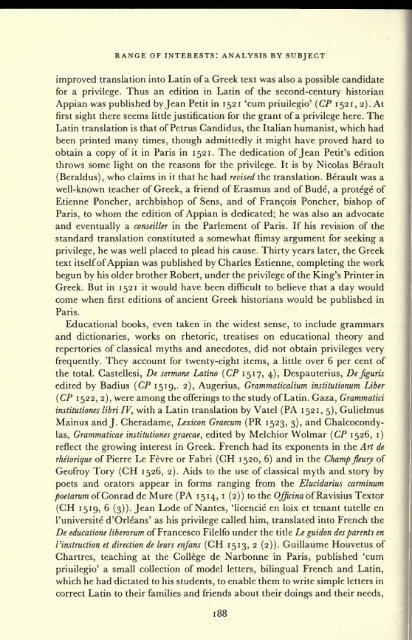Untitled - Monoskop
Untitled - Monoskop
Untitled - Monoskop
Create successful ePaper yourself
Turn your PDF publications into a flip-book with our unique Google optimized e-Paper software.
RANGE OF INTERESTS: ANALYSIS BY SUBJECT<br />
improved translation into Latin of a Greek text was also a possible candidate<br />
for a privilege. Thus an edition in Latin of the second-century historian<br />
Appian was published by Jean Petit in 1521 'cum priuilegio' (CP 1521, 2). At<br />
first sight there seems little justification for the grant of a privilege here. The<br />
Latin translation is that of Petrus Candidus, the Italian humanist, which had<br />
been printed many times, though admittedly it might have proved hard to<br />
obtain a copy of it in Paris in 1521. The dedication of Jean Petit's edition<br />
throws some light on the reasons for the privilege. It is by Nicolas Berault<br />
(Beraldus), who claims in it that he had revised the translation. Berault was a<br />
well-known teacher of Greek, a friend of Erasmus and of Bude, a protege of<br />
Etienne Poncher, archbishop of Sens, and of Frangois Poncher, bishop of<br />
Paris, to whom the edition of Appian is dedicated; he was also an advocate<br />
and eventually a conseiller in the Parlement of Paris. If his revision of the<br />
standard translation constituted a somewhat flimsy argument for seeking a<br />
privilege, he was well placed to plead his cause. Thirty years later, the Greek<br />
text itself of Appian was published by Charles Estienne, completing the work<br />
begun by his older brother Robert, under the privilege of the King's Printer in<br />
Greek. But in 1521 it would have been difficult to believe that a day would<br />
come when first editions of ancient Greek historians would be published in<br />
Paris.<br />
Educational books, even taken in the widest sense, to include grammars<br />
and dictionaries, works on rhetoric, treatises on educational theory and<br />
repertories of classical myths and anecdotes, did not obtain privileges very<br />
frequently. They account for twenty-eight items, a little over 6 per cent of<br />
the total. Castellesi, De sermone Latino (CP 1517, 4), Despauterius, De figuris<br />
edited by Badius (CP 1519,. 2), Augerius, Grammaticalium institutionum Liber<br />
(CP 1522, 2), were among the offerings to the study of Latin. Gaza, Grammatici<br />
institutiones libri IV, with a Latin translation by Vatel (PA 1521, 5), Gulielmus<br />
Mainus and J. Cheradame, Lexicon Graecum (PR 1523, 3), and Chalcocondy-<br />
las, Grammaticae institutiones graecae, edited by Melchior Wolmar (CP 1526, i)<br />
reflect the growing interest in Greek. French had its exponents in the Art de<br />
rhetorique of Pierre Le Fevre or Fabri (CH 1520, 6) and in the Champ fleury of<br />
Geofroy Tory (CH 1526, 2). Aids to the use of classical myth and story by<br />
poets and orators appear in forms ranging from the Elucidarius carminum<br />
of Ravisius Textor<br />
poetarum ofConrad de Mure (PA 1514, i (2)) to the Offaina<br />
(CH 1519, 6 (3)). Jean Lode of Nantes, 'licencie en loix et tenant tutelle en<br />
1'universite d'Orleans' as his privilege called him, translated into French the<br />
De educatione liberorum of Francesco Filelfo under the title Le guidon des parents en<br />
I'instruction et direction de leurs enfans (CH 1513, 2 (2)). Guillaume Houvetus of<br />
Chartres, teaching at the College de Narbonne in Paris, published 'cum<br />
priuilegio' a small collection of model letters, bilingual French and Latin,<br />
which he had dictated to his students, to enable them to write simple letters in<br />
correct Latin to their families and friends about their doings and their needs,<br />
1 88

















